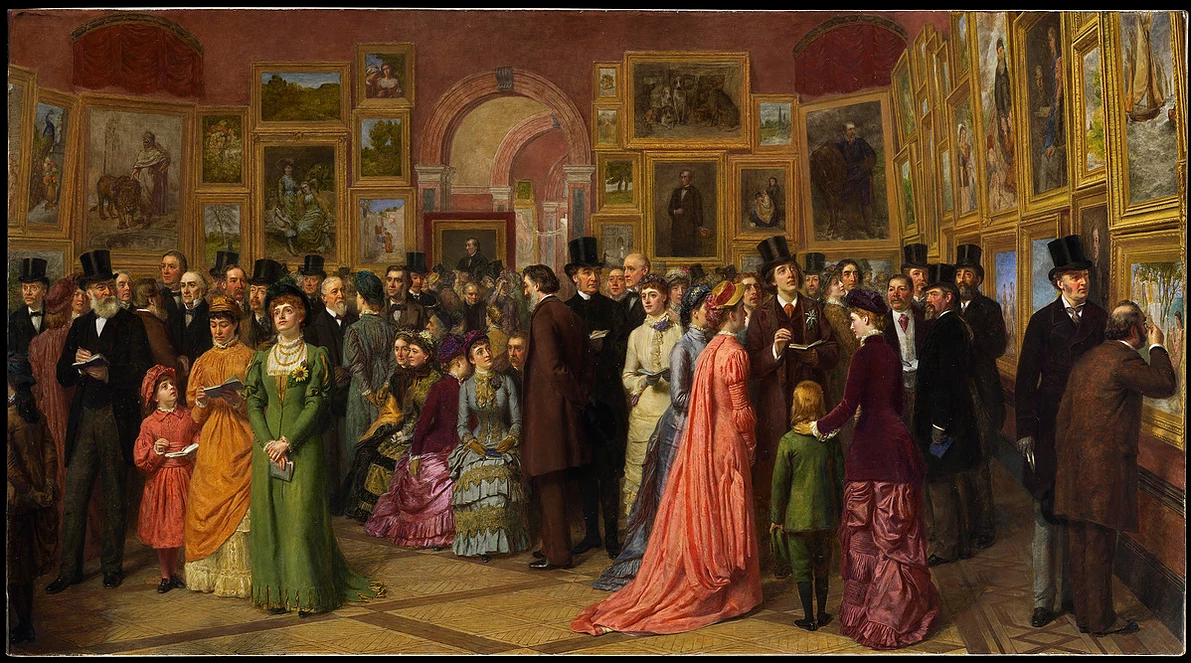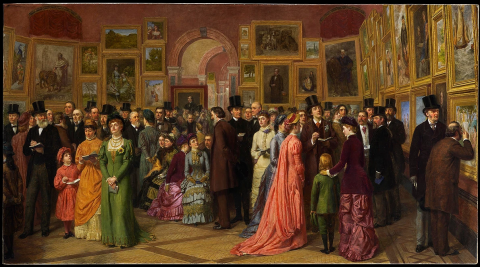Introduction
In March 2020, the confirmation by the World Health Organization that coronavirus had become a pandemic led to the widespread adoption of a series of prevention and mitigation measures that affected the daily lives of citizens around the world. Among these were the closure of museums and cultural centres of all kinds, regardless of their collections, size, or ownership.
These closures have affected thousands of museum professionals around the world. This article addresses the impact of this situation on their day to day. This is the first study focused specifically on this group rather than on the institutions for which they work or worked.
The information presented in the following pages has been drawn from a survey disseminated among international museum workers and carried out between the end of April and the beginning of May 2020.
State of the Question
The present study acknowledges and is connected to a wider panorama of reflections, debates, surveys, and studies that have proliferated and developed since March as many museums worldwide were forced to remain closed.
In fact, in this unprecedented situation the information shared through surveys has become a key tool through which local, national and international cultural organisations, museums and museum professionals are assessing the consequences of the health crisis for their sector in order to offer answers to some of the uncertainties concerning the present and the future of museums.
The most extensive studies carried out so far have mainly focused on three aspects:
- The economic impact of COVID-19 on museums, in terms of income, staff layoffs or alternative sources of funding.
- The reactions of institutions to closures, particularly in terms of the development of digital strategies.
- Forecasts and scenarios for reopening.
In this respect, one of the studies with the greatest impact has been that of NEMO (Network of European Museum Organizations). On March 26 it launched a survey that addressed both the economic aspects – loss of income, impact on staff, alternative sources of funding – and the digitisation process of institutional activity – digital profile, online visitor numbers, usage of social media, popularity of online services – in different European museums. It also collated examples of good practices from different institutions regarding their response to the crisis, their online presence, or their reopening plans. The survey was active until April 30 and the results and relevant recommendations were published on May 12, which can be found here.
UNESCO and ICOM have also carried out their respective surveys. In the case of ICOM, on April 28 it launched a survey that, under the title “Museums, museum professionals and COVID-19”, tried to collect data concerning the situation of museums (open or closed), the economic impact of the crisis, the changes in digital activity or the security and conservation conditions in their premises during the closure. Regarding the working conditions of the professionals in the sector, the survey addressed the situation of both self-employed and contracted staff in terms of office work, remote work, compulsory annual leave, furlough, or dismissal. The survey ended on May 7 and the results were published on May 26; it concluded that in 84% of the surveyed museums the staff had worked from home and that 6% of the temporary contracts had not been renewed during the closure. The full ICOM study is available here.
In the case of UNESCO, the survey was carried out between May 16 and 20. The final report was also published on May 26, incorporating data from other sources such as the study of the NEMO network, specialised sites, the press or UNESCO's own network of international delegations.
Similarly, the Ibermuseos network launched an international survey on April 16 to collect data on the conditions, needs and expectations of museums in the Ibero-American area. The results of this survey have not yet been published.
In the context of Spain, on April 2 the Department of Culture of the Generalitat de Catalunya issued a form addressed to the museums of the region in which it assessed the effects of COVID-19 on their different activities, on the staff (both internal and outsourced) and on the work arrangements adopted (full or part time, teleworking, temporary suspension, etc.), as well as on the museum's income and expenses. The results of the survey can be seen here.
Instead of presenting an exhaustive study of the different surveys and reports that have been carried out on the subject of museums and COVID-19 [1], at this point it is important to highlight that, so far, the impact of the situation on museum workers has been approached tangentially in most cases, and from a markedly economic perspective, as seen on the NEMO survey. The specific focus of the study that we present – the impact of COVID-19 on the day-to-day work of museum professionals – has only been touched on by ICOM in terms of the general employment situation, without going in depth into the conditions in which these employees carry out their tasks (where applicable). Therefore, we currently do not have other results that can complement our survey.
Methodology
The data collection on which this article is based was carried out through a public questionnaire that was disseminated by various means. This was addressed to active museum professionals and to employees who interrupted their activity due to the crisis unleashed by COVID-19.
The questionnaire was generated through Google Forms and consisted of 21 sections with a variable number of questions per section. Although the total number of questions was 34, these were designed to guide the participant through different routes based on their answers, so that none of them had to answer to all the questions.
The common questions collected personal data of the respondents, their countries of origin, the institutions for which they work or worked, their potential closing date and the perception of their performance during the COVID-19 crisis.
The questionnaire was produced in English and Spanish and the data was collected between April 22 and May 4, 2020. The dissemination was done by electronic means: on the one hand, by sending it directly to participants who had been previously contacted and, on the other, by posting it in specific museum-related groups on social media. Both the participants contacted directly and those engaged through indirect means contributed to triggering a snowball effect, expanding the scope of the data collection.
A total of 40 questionnaires were received, 39 being valid and one duplicate. Of these 39 valid questionnaires, 20 were answered in English and 19 in Spanish.
Data analysis and results
In order to guarantee the privacy of all participants, employees were asked about the possibility of publishing the name of the institution for which they work or worked. The majority chose not to disclose the name of their institution. Among the respondents who agreed to have their institutions’ names published are staff members of the Prado National Museum (2) and the National Museum of Science and Technology in Spain (1), the Københavns Museum (1), the Ny Carlsberg Glyptoteket (1) and the National Museum in Denmark (1), the Museum Martena in the Netherlands (1), the Headstone Manor & Museum in the United Kingdom (1), the Paranaense Museum in Brazil (1), the Vytautas the great war museum in Lithuania (1), as well as the Kittitas County Historical Museum (1) and the Japanese Society (1) in the United States. The Julia Betancor studio-laboratory for conservation and restoration has also participated in the survey, which, although it is not a museum, works directly for the sector.
In addition to workers from other museums in these same countries (14 from Spain; 5 from the United Kingdom), workers from the sector from Greece (1) and Mexico (1) are also represented in the study.


Most of the workers included in the survey have a long professional career in the museum sector. The largest volume of responses, sixteen, is from workers with a professional experience that exceeds 10 years, followed by workers who have been in the sector between 4 and 10 years, with fourteen responses. Finally, the least represented, with nine responses, are workers with an experience of between 0 and 3 years. Among all of them, a high percentage work in departments related to education (learning or mediation), but workers who occupy different roles in departments are also represented. Taking into account the heterogeneity of departments and positions in the different museums, these could be broadly grouped as conservation, visitor services, collections, exhibitions, marketing and communication, and other services (bookstore).


At the time of responding to the survey, all the institutions where the participating workers carry or carried out their duties were closed, with one exception: the Julia Betancor conservation studio-laboratory. This institution – following a series of questions only available to the option "yes, the institution is currently open" – closed temporarily from March 12 and reopened before April 29. During the period of temporary closure, the workers did not carry out their work and, once reopened, they continue to work remotely.

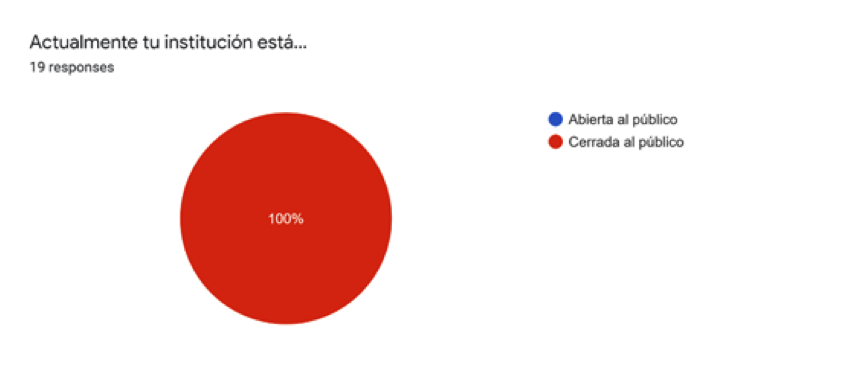

The responses to the questionnaires highlight that the decisions to close the museums, in most cases, were taken by national governments, although some of the workers show that this decision came from the museums themselves, probably before official governmental instructions were in place. In Spain, Greece, Denmark, Brazil, Lithuania, Mexico and the Netherlands, national governments decreed exceptional measures to close cultural institutions. In the case of the United States –and initially in the United Kingdom–, the closure of museums was triggered by leading institutions, mainly from London, New York, Boston, and Washington. The four museum workers from the United States who responded to the survey coincided in that their own institutions took the decision to close.


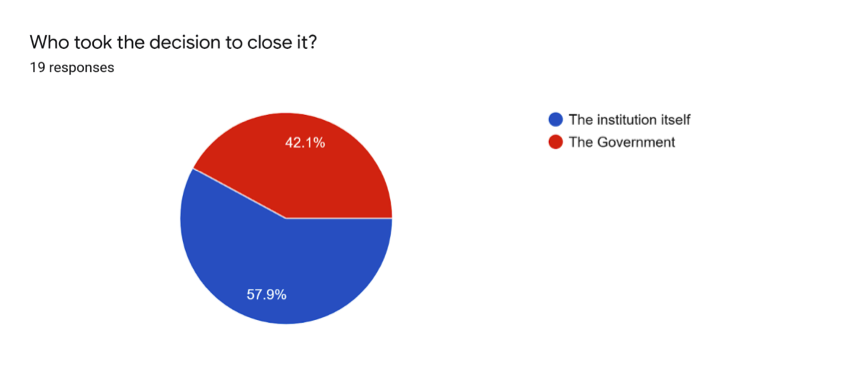
Regarding the emergency funding available for the cultural sector, there is a striking difference between the responses summarising the Spanish national scene, represented by the questionnaire in Spanish, and those describing the international scene, represented by the questionnaire in English. While in Spain only four workers report the existence of funding for which their institutions could apply, in the international arena most workers ratify the existence of extra help. This is the case in 100% of the museums in the Netherlands, the United States and Greece. In the case of Denmark, two of the three participating workers confirmed that their institution received help, while a third replied that it did not. Of the six respondents working in UK museums, one replied negatively to the possibility that their institution might qualify for funding to cope with the COVID-19 crisis. Museum workers in Mexico, Brazil, and Lithuania state that their institutions did not have emergency funding available at the time of responding to the survey.



Most of the surveyed workers continue to work for their institutions despite the closure. In Spain, ten workers have kept their jobs, all of them in national museums and other state public institutions, and occupying positions in departments of education, collections, public activities, conservation, and communication, as well as visitor services. Ten other employees are not currently working, seven of whom are mediators or visitor services staff at the same private institution, one is a mediator at various institutions in Madrid, one is a museum library worker and the last is a conservator connected to a national museum (the answer is recorded in the graph in English).
All the international participants state that they have kept their jobs.



The employees who replied that they did not continue working for their institution were asked about the prospects of recovering their post once the crisis ended. In this sense, the outlook is quite positive: none of the ten workers replied that they did not expect to recover their position. On the contrary, all were planning to return to their jobs except for three of them, from different institutions, who were still in doubt.
Six of these workers stated that they had received specific financial help, while four workers (three in the Spanish questionnaire and one in the English questionnaire) declared that they had not received any support. Three of the workers who received financial help and three of those who have not, belong to the same private institution.




Among the group of active workers, the questionnaires in both languages show that during the COVID-19 crisis very few professionals continued to attend their institution. The four people who carried on going to the office are from Brazil (Museu Paranaense), Denmark (Ny Carlsberg Glyptoteket), the United States (Kittitas County Historical Museum) and the Netherlands (Museum Martena). One of these responses is especially significant because it belongs to a person in charge of conservation and restoration, who stated that she had no other way of doing her job. This reflects the contrast between different levels of lockdown in each country given that in Spain, for example, a conservator who had to shift to remote work due to the impossibility of travelling to the workshop explains that, in her case, a toll of hours has been organised, which will need to be compensated for in person when a certain degree of normality is restored.


However, the challenges of working remotely are not limited to not being in contact with collections or not being able to interact with audiences. More administrative profiles and non-public-facing roles also need to have access to a series of essential tools to carry out their tasks. When addressing this issue, a marked difference is observed between the Spanish and international panorama. Compared to 70% of Spanish respondents who state that their institution has not provided them with specific technical resources to carry out their duties, only 40% of international respondents admit to being in a similar situation.
This trend is further accentuated when workers are asked whether they have access to everything they need to carry out their work satisfactorily: in Spain 80% answer no, while more than 93% of professionals who answered to the questionnaire in English reply affirmatively.




It should be noted that this question presents a bias because among the Spanish employees there are fifteen respondents whose duties are related to audiences. By their own nature, these roles have more difficulties to carry out their tasks remotely given that they depend on the influx of visitors.
Linked to the above, there is an appreciable percentage of respondents who reply that their tasks have varied during the crisis, exceeding 50% in the case of international professionals. In the Spanish questionnaire, only two people arrived to this question because it was only activated when the respondent answered "yes" to the previous section (that is, that they do have access to all the materials and tools necessary to carry out their work). Given that in the survey in Spanish only 20% answered affirmatively, this question had hardly any answers.
After declaring that they have access to everything necessary to work but that the tasks have changed, the respondent was invited to offer more information about these changes. Below are some of the most prominent responses in both languages:
- Las circunstancias actuales han impulsado la necesidad de desarrollar alternativas en línea a algunas de las propuestas educativas que se hacían de manera presencial en el museo. Del mismo modo, nos ha servido también para explorar la elaboración de materiales en formato digital que, sin ser novedosos en el campo de los museos, aún no se habían trabajado en la institución para la que trabajo. Esto ha llevado parejo un cambio en el sistema de trabajo y los protocolos que, hasta ahora, se habían establecido y que aún quedan lejos de estar firmemente coordinados y consolidados. [Current circumstances have driven the need to develop online alternatives to some of the educational activities that were carried out in person at the museum. In the same way, it has also helped us to explore the elaboration of materials in digital format that, without being novel in the field of museums, had not yet been incorporated in the institution for which I work. This has led to a change in the working system and protocols that, until now, had only been established and that are still far from being firmly coordinated and consolidated.]
- Normally I am Head of Learning. However, in addition to overseeing our learning programs (which where possible are digital, although in some cases have now been paused) I have been made editor of the museum’s digital program. This means I am working across curatorial, learning, comms, and the collection team to coordinate this.
- All public-facing tasks: lectures and talks, are on hold; forward planning for exhibitions is uncertain as we are not sure whether they will take place physically or not, whether they will only be online. We are placing more emphasis on preparing content - information about exhibitions, collections etc, for digital format. We are now on Google Arts and are working towards uploading material to that forum.
As observed in the three responses, a few main ideas recur: uncertainty about the future and consequently the need to react on the spot, the implementation of operating models that requires an unusual close collaboration between departments, and a concern to go digital as quickly as possible. These three ideas, isolated or in combination, are mentioned in one way or another in all the answers recorded in this section.
On the other hand, when respondent answered “no” (without access to everything necessary to carry out their tasks) they were invited to explain to what extent they had adapted their way of working. Most of the answers denote that the respondents focus predominantly on areas to which they had previously paid less attention or dedicated less time due to the constraints derived from the rest of their workload, such as the production and dissemination of digital content. New work procedures include video calls, instant messaging services, and various remote or cloud storage options.


Regarding the management of the crisis from a psychological point of view, participants were asked to assess three aspects related to their professional performance: concentration, motivation, and productivity. They were then asked to compare this assessment with the assessment they would have made of the same three aspects before the crisis, with 1 being the lowest scores and 5 the highest.
Again, this question was only activated when the respondent answered that they were still working for their institution, so 9 responses were recorded in the Spanish questionnaire as opposed to 18 in the English questionnaire.
Regarding the ability to concentrate, the responses to the questionnaire in Spanish show a greater diversity than those to the questionnaire in English, which opt for intermediate values (3) also when assessing motivation and productivity. By contrast, Spanish respondents have a tendency to opt for higher values (4). Both in one questionnaire and another, the ability to concentrate is at the average or above.
Regarding motivation, in absolute terms a more positive assessment is observed among Spanish respondents than among international respondents, while productivity is practically comparable.

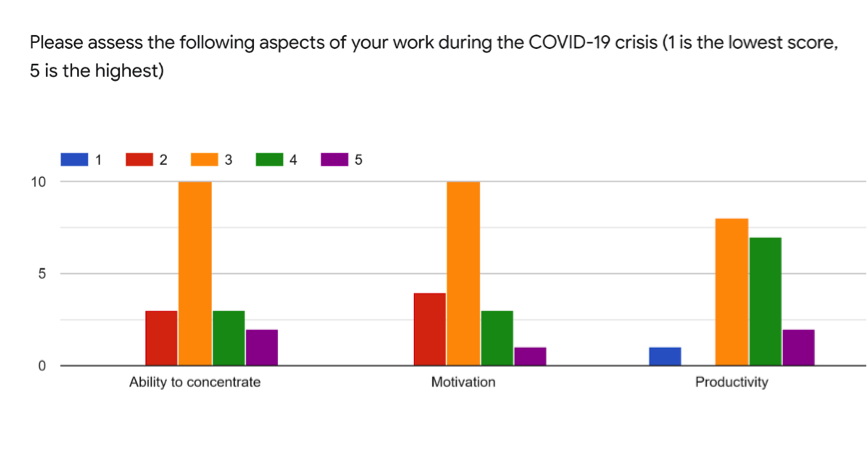
The comparison between past and present denotes that, in general, museum professionals consider that the impact of the health crisis has had a negative effect on their performance. Both in Spain and abroad, the three items have decreased, although the motivation of the Spanish respondents stands out for its resilience as there are more neutral than negative responses. Productivity also appears to have been more stable than among English-speaking respondents. In contrast to this, the increase in productivity does not feature in the Spanish questionnaires, while among international respondents it exceeds neutrality and therefore produces a more polarized result between the decrease and the increase.

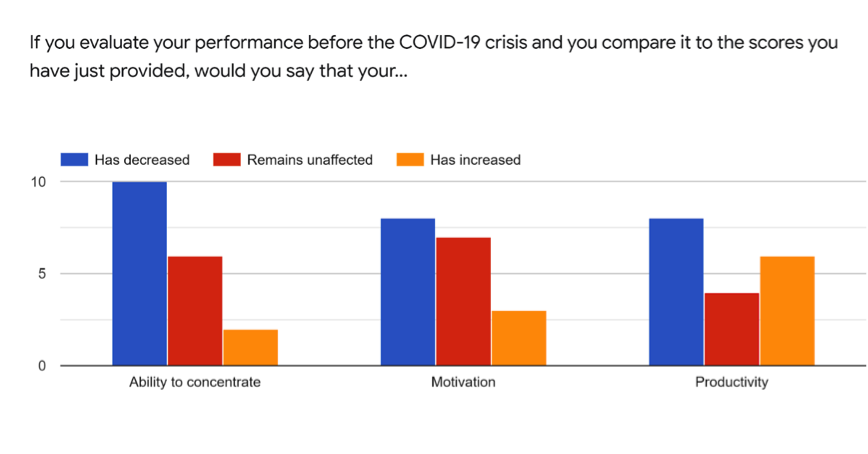
Another subject the respondents were asked about was their level of information and involvement regarding the spread and mitigation of the crisis within their professional sector. Again, the differences between the questionnaire in Spanish and the questionnaire in English are noticeable.
When asked if they were following the development of the mitigation and operational measures being proposed worldwide, 52.6% of Spanish-speakers employees stated that they were aware of them, compared to 85% of international respondents.
The next question focused on the personal involvement of each respondent in initiatives of diverse territorial and institutional scope that aimed to analyse and alleviate the effects of the crisis in the museum world. Not surprisingly, the disparity in the levels of follow-up between the two questionnaires also resulted in an uneven involvement, lower among Spanish museum workers, with only 3 people involved, compared to 13 on the international scene.





Finally, the questionnaire invited museum professionals to voluntarily provide any additional information or assessment they wished to make regarding their work during this crisis. Again, some of the responses are presented in both languages:
- Necesidad de reflexión sobre la mejora de las condiciones físicas y psicológicas del trabajo. La responsabilidad de cada trabajador permite la autoorganización del trabajo diario (aprovechamiento del tiempo, priorización de tareas, elección de las condiciones del puesto) mejorando su calidad. Sin embargo, la imposibilidad de acceso a las instalaciones y, especialmente, la no interacción entre público y colección hace que, de mantenerse la situación por un período muy prolongado, la naturaleza de mi puesto de trabajo pierda gran parte de su sentido. [Need for reflection on improving the physical and psychological conditions of work. The responsibility of each worker allows the self-organization of daily work (use of time, prioritisation of tasks, choice of job conditions), improving its quality. However, the impossibility of accessing the facilities and, especially, the non-interaction between the public and the collection means that, if the situation continues for a very long period, the nature of my job loses much of its meaning.]
- El futuro del museo es incierto ya que nuestro primer aniversario se celebró en pleno estado de alarma, las visitas de grupos organizadas se cancelaron al igual que todos los actos que teníamos previsto. Desde mi punto de vista, trabajador del sector cultural de ámbito privado, veo cómo peligran nuestros puestos de trabajo y no se ve la luz al final del túnel. [The future of the museum is uncertain since our first anniversary was celebrated in a state of alarm, the visits of organized groups were cancelled, as were all the events we had planned. From my point of view, a private sector worker in the cultural sector, I see how our jobs are in danger and there is no light at the end of the tunnel.]
- It is fine working (especially when writing essays etc) from home. But home is also family and many other obligations that cannot be fulfilled simultaneously.
- I find working at home not ideal because I have not been accustomed to it, do not have a designated office-type space in which to work, and of course the house is much fuller and noisier than usual with all the family constantly at home . I have never missed the privacy and quiet of my own office as much as I do now!
- This has shifted our institutional purpose; We've moved into a bigger role of advocacy and information dissemination instead of just being a cultural center.
Conclusions
As anticipated at the beginning of this article, this analysis does not constitute an exhaustive study of the current situation of museum professionals. The small sample size, the limited time for data collection and the relatively low dissemination of the survey demand a careful reading that avoids interpreting the results as an accurate summary of the situation in any of the participating countries.
However, the fact that this is the first study specifically designed to evaluate the experience of this crisis from the point of view of museum professionals, and not from their respective institutions, endows it with a relevance that resides in its approach, given that it focuses on the person rather than on their role.
From this perspective, this article collects the experiences and testimonies of 39 individuals from diverse contexts and who are going through disparate personal and work situations but whose challenges in many cases overlap: difficulties in accessing tools or materials, working in conditions that diverge from the usual ones, using new methods or platforms, rethinking dynamics and tasks, etc. In isolation, none of them can speak on behalf of their nations or even their institutions, but if with a sample size of these characteristics a series of repetitive ideas are already appreciable, it can be assumed that a larger sample would possibly delve even further into many of these issues. Therefore, the set of observations presented in the preceding pages does not have an absolute value, but it does act as an indicator of a trend and, we hope, as a catalyst for future debates and lines of research.
At the same time, focusing on staff evidenced something that, unsurprisingly, probably has less weight in institution-oriented surveys: a sense of prudence against potential undesired consequences at work. Several of the respondents agreed to participate only when informed that their responses would be anonymous and that the name of their museum would not be disclosed if they did not authorise it. It was necessary to guarantee that tracing would be impossible.
This fear, as seen above, affects Spanish employees to a greater extent. This may have been another factor that determined the sample size, but at the same time it attests to a fragile work environment in which job insecurity and the self-consciousness of its professionals encourages them not to draw attention to themselves. Not surprisingly, several of the participants were unemployed at the time of responding to the survey, but with plans to be readmitted later, so their desire for anonymity is likely to be a precautionary measure.
Despite the above, and as a means of qualifying the negative assessment offered by themselves, the results of this study allow for a fairly positive evaluation to be made regarding the psychological resilience of museum professionals. If we compare the graphs that evaluate the ability to concentrate, motivation and productivity during the crisis with the graphs that put them in relation to the performance prior to this period, it can be inferred that, despite the decrease in these abilities in many cases, the starting point must have been very high – or the decline must have been very small –for its reduction to still place them at predominantly intermediate values. In other words, workers undoubtedly show some attrition, particularly with regard to their ability to concentrate in the Spanish case, but despite this, for example, they estimate that their productivity is on average or above it (3–4). At the same time, a significant number respond that their productivity has decreased, from which it follows that under normal conditions their productivity would have been higher than previously declared (4–5, perhaps).
The answers to the open questions also suggest extremely broad topics that unfortunately cannot be dealt with in depth in the present study, given that they do not exclusively concern the museum world. That is the case of the greater or lesser prior preparation of employees and institutions to adopt remote work, as well as its viability according to different museum roles.
The difficulties of reconciling work and family life also appear in the specific context of compulsory telework, as well as allusions to the mental and physical well-being of workers. Uncertainty translates into a certain degree of pessimism in the face of difficulties in the short, medium, and long term.
Finally, doubts are also raised about the very purpose of cultural institutions and the role of the museum (and by extension of its employees), in a future in which the direct relationship between the public and cultural assets could potentially be attenuated or even suspended.
In conclusion, it is evident that the circumstances in which this research was carried out have been determined by an unprecedented and continually evolving context, and its consequences may not fully emerge immediately. The real impact of this crisis on the cultural sector and its professionals will only be adequately assessed with the perspective and critical vision provided by the passage of time.
Many other national bodies have published survey-based studies, such as the Art Fund (National Collection Art Fund, United Kingdom) or the IAC (Institute of Contemporary Art, Spain). Complete lists of resources on museums and COVID-19 can be found on the ICOM website or on the website of the Spanish Museum Observatory.
Notas:
[1] Many other national bodies have published survey-based studies, such as the Art Fund (National Collection Art Fund, Reino Unido) or the IAC (Institute of Contemporary Art, Spain). Complete lists of resources on museums and COVID-19 can be found on the ICOM website or the website of the Spanish Museum Observatory.

